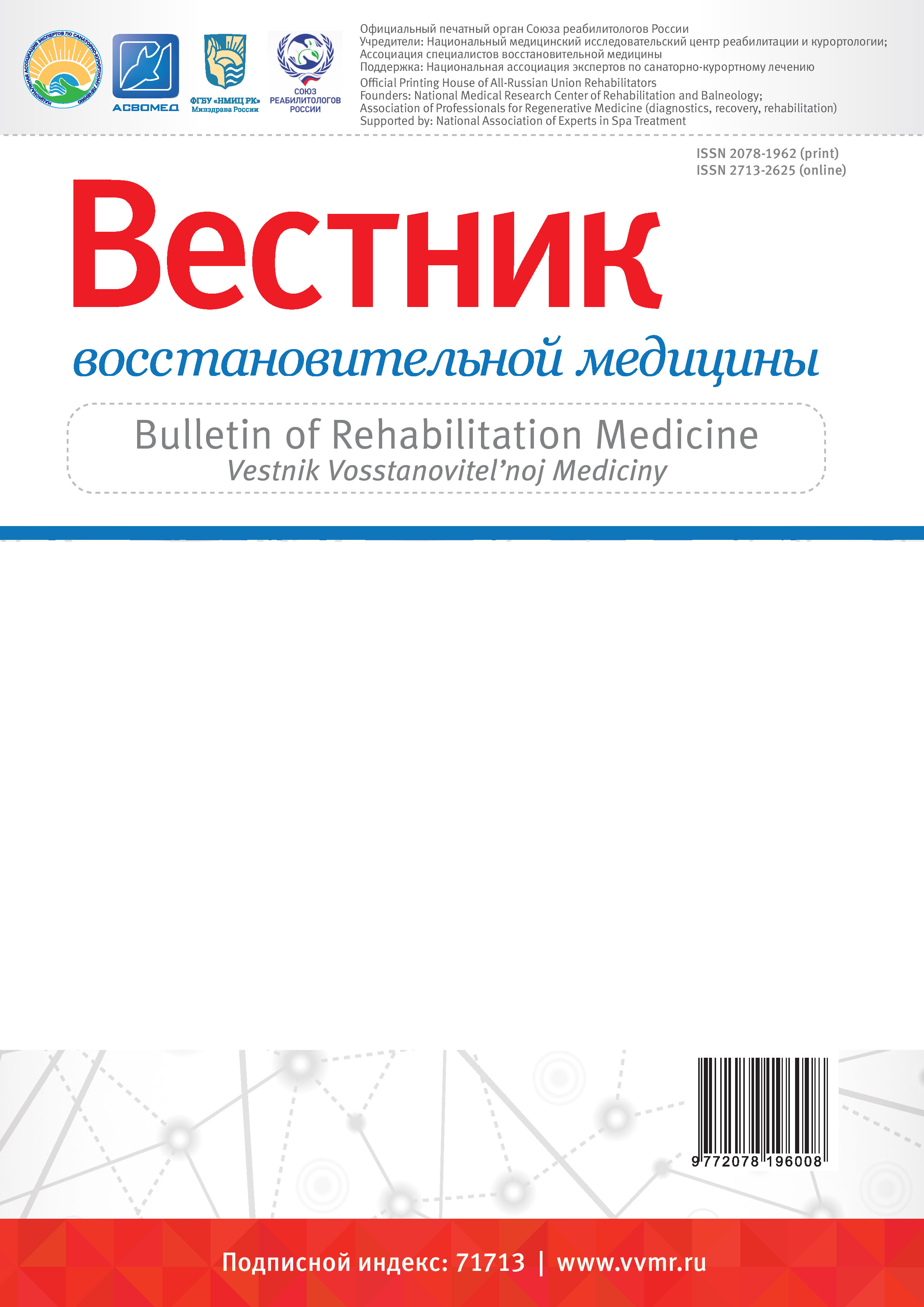INTRODUCTION. The therapeutic strategies for managing patients with comorbid conditions, such as arterial hypertension (AH) and prediabetes, are widely adopting non-drug methods along with the recommended medications. AIM. To evaluate the effect on fat distribution and humoral status of sulfide balneotherapy in the conditions of the experiment on white rats and clinical study of AH and prediabetes patients. MATERIAL AND METHODS. The study was of a clinical and experimental nature and consisted of 2 phases – experimental and clinical. The experimental study was carried out on obese, non-pedigreed white rats. Animals were exposed to sulfide baths and a combination of sulfide applications and baths. In the clinical phase of the study, patients with AH and prediabetes were included. All patients included in the present study received standardised drug therapy according to clinical guidelines, and patients in the observation group additionally received combined sulphide balneotherapy (Suksun lake sulphide applications and baths) for 14 days. The study program included assessment of weight, waist circumference (WC), body mass index (BMI), assessment of serum concentrations of vascular endothelial growth factor (VEGF); tissue growth factor (TGF b), insulin and leptin, as well as determination of epicardial fa thickness (EFT). RESULTS AND DISCUSSION. The experimental conditions revealed lipolysis in adipocytes (omentum), as well as an increase in the number of hemocapillaries in all areas of the heart and the growth of CD34 expression. The results of the clinical stage of the study suggest redistribution of fat depots against the background of sulfide balneotherapy. There were no statistically significant differences in weight and BMI in the dynamics, but there was a significant decrease in OT and TEF in the group of patients who received balneotherapy, who also had a significant decrease in HEFR concentration, leptin and an increase in TEFR beta 1. CONCLUSION. The presence of lipolytic, regenerative and adipokine-regulating effects of sulfide balneotherapy was demonstrated in the experiment and clinical study.
hypertension, prediabetic state, balneotherapy, nutritional status, cytokines, immunohistochemistry
1. Zywicki V., Capozza P., Caravelli P., Del Prato S., De Caterina R. Glucose tolerance and markers of myocardial injury after an acute coronary syndrome: predictive role of the 1-h plus 2-h plasma glucose at the oral glucose tolerance test. Cardiovascular Diabetology. 2022; 21(1): 152 p. https://doi.org/10.1186/s12933-022-01590-w
2. Shahim B., De Bacquer D., De Backer G., Gyberg V., Kotseva K., Mellbin L., Schnell O., Tuomilehto J., Wood D., Ryden L. The prognostic value of fasting plasma glucose, two-hour postload glucose, and HbA1c in patients with coronary artery disease: a report from EUROASPIRE IV: a survey from the European Society of Cardiology. Diabetes Care. 2017; (40): 1233-1240. https://doi.org/10.2337/dc17-0245
3. Liu N., Sheng J., Wang Y. Effect of stress hyperglycaemia on monocyte chemoattractant protein-1 levels and the short-term prognosis of patients with acute ST-segment elevation myocardial infarction undergoing primary percutaneous coronary intervention. Experimental and Therapeutic Medicine. 2019; 17(5): 3823-3829. https://doi.org/10.3892/etm.2019.7338
4. Shishko E.I., Mohort T.V., Mohort E.G. Narusheniya endokrinnoy regulyacii pri zabolevaniyah, svyazannyh s insulinorezistentnost'yu. Lechebnoe delo: nauchno-prakticheskiy terapevticheskiy zhurnal. 2016; (5): 76-81.
5. Wu W., Wu Y., Yang J., Sun D., Wang Y., Ni Z., Yang F., Xie Y., Tan X., Li L., Li L. Relationship between obesity indicators and hypertension-diabetes comorbidity among adults: a population study from Central China. BMJ Open. 2022; 12(7): e052674. https://doi.org/10.1136/bmjopen-2021-052674
6. Garbuzenko D.V. Pathophysiological mechanisms of cardiovascular disorders in non-alcoholic fatty liver disease. Gastroenterology and Hepatology from Bed to Bench. 2022; 15(3): 194-203. https://doi.org/10.22037/ghfbb.v15i3.2549
7. Litvinova L.S., Kirienkova E.V., Mazurin I.O. Patogenez insulinorezistentnosti pri metabolicheskom ozhirenii. Biomedicinskaya himiya. 2015; 61(1): 70-82. https://doi.org/10.18097/PBMC20156101070
8. Tucker L.A. Fiber Intake and Insulin Resistance in 6374 Adults: The Role of Abdominal Obesity. Nutrients. 2018; 10(2): 237 p. https://doi.org/10.3390/nu10020237
9. Pileggi C.A., Hooks B.G., McPherson R., Dent R.R.M., Harper M.E. Targeting skeletal muscle mitochondrial health in obesity. Clinical Science. 2022; 136(14): 1081-1110. https://doi.org/10.1042/CS20210506
10. Hruby A., Hu F.B. The Epidemiology of Obesity: A Big Picture. PharmacoEconomics. 2015; 33(7): 673-89. https://doi.org/10.1007/s40273-014-0243-x
11. Lambadiari V., Dimitriadis G., Kadoglou N.P.E. The impact of oral anti-diabetic medications on heart failure: lessons learned from preclinical studies. Heart Failure Reviews. 2018; 23(3): 337-346. https://doi.org/10.1007/s10741-018-9690-3
12. Flegal K.M., Kit B.K., Orpana H., Graubard B.I. Association of all-cause mortality with overweight and obesity using standard body mass index categories: a systematic review and meta-analysis. JAMA. 2013; 309(1): 71-82. https://doi.org/10.1001/jama.2012.113905
13. Kanic V., Frank B., Kompara G., Suran D. Differential associations between body mass index and outcome in different age groups in patients with myocardial infarction. Indian Heart Journal. 2022; 74(4): 289-295. https://doi.org/10.1016/j.ihj.2022.06.004
14. Borodkina D.A., Gruzdeva O.V., Kvitkova L.V., Barbarash O.L. Raspredelenie zhirovyh otlozheniy: razgadka kazhuschegosya paradoksa ozhireniya v kardiologii? Ozhirenie i metabolizm. 2017; 14(2): 3-8. https://doi.org/10.14341/OMET201723-8
15. Drapkina O.M., Shepel' R.N., Deeva T.A. Tolschina epikardial'nogo zhira - «vizitnaya kartochka» metabolicheskogo sindroma. Ozhirenie i metabolizm. 2018; 15(2): 29-34. https://doi.org/10.14341/omet9295
16. Koksharova E.O., Mayorov A.Yu., Shestakova M.V., Dedov I.I. Metabolicheskie osobennosti i terapevticheskiy potencial buroy i «bezhevoy» zhirovoy tkani. Saharnyy diabet. 2014; (4): 5-15.
17. Schleinitz D., Krause K., Wohland T., Gebhardt C., Linder N., Stumvoll M., Blüher M., Bechmann I., Kovacs P., Gericke M., Tönjes A. Identification of distinct transcriptome signatures of human adipose tissue from fifteen depots. European Journal of Human Genetics. 2020; 28(12): 1714-1725. https://doi.org/10.1038/s41431-020-0681-1
18. Armstrong A., Jungbluth Rodriguez K., Sabag A., Mavros Y., Parker H.M., Keating S.E., Johnson N.A. Effect of aerobic exercise on waist circumference in adults with overweight or obesity: A systematic review and meta-analysis. Obesity Reviews. 2022; 23(8): e13446. https://doi.org/10.1111/obr.13446
19. Geng Y., Faber K.N., de Meijer V.E., Blokzijl H., Moshage H. How does hepatic lipid accumulation lead to lipotoxicity in non-alcoholic fatty liver disease? Hepatology International. 2021; 15(1): 21-35. https://doi.org/10.1007/s12072-020-10121-2
20. Karampetsou N., Alexopoulos L., Minia A., Pliaka V., Tsolakos N., Kontzoglou K., Perrea D.N., Patapis P. Epicardial Adipose Tissue as an Independent Cardiometabolic Risk Factor for Coronary Artery Disease. Cureus. 2022; 14(6): e25578. https://doi.org/10.7759/cureus.25578
21. Liu J., Mesfin F.M., Hunter C.E., Olson K.R., Shelley W.C., Brokaw J.P., Manohar K., Markel T.A. Recent Development of the Molecular and Cellular Mechanisms of Hydrogen Sulfide Gasotransmitter. Antioxidants. 2022; 11(9): 1788. https://doi.org/10.3390/antiox11091788
22. Hussain Lodhi A., Ahmad F.U., Furwa K., Madni A. Role of Oxidative Stress and Reduced Endogenous Hydrogen Sulfide in Diabetic Nephropathy. Drug Design, Development and Therapy. 2021; (15): 1031-1043. https://doi.org/10.2147/DDDT.S291591
23. Manandhar S., Sinha P., Ejiwale G., Bhatia M. Hydrogen Sulfide and its Interaction with Other Players in Inflammation. Advances in Experimental Medicine and Biology. 2021; (1315): 129-159. https://doi.org/10.1007/978-981-16-0991-6_6
24. Yu W., Jin H., Tang C., Du J., Zhang Z. Sulfur-containing gaseous signal molecules, ion channels and cardiovascular diseases. British Journal of Pharmacology. 2018; 175(8): 1114-1125. https://doi.org/10.1111/bph.13829
25. Chen H.J., Ngowi E.E., Qian L., Li T., Qin Y.Z., Zhou J.J., Li K., Ji X.Y., Wu D.D. Role of Hydrogen Sulfide in the Endocrine System. Frontiers in Endocrinology. 2021; (12): 704620. https://doi.org/10.3389/fendo.2021.704620
26. Vasil'ev V.S., Manturova N.E., Vasil'ev S.A., Teryushkova Zh.I. Biologicheskaya harakteristika zhirovoy tkani. Plasticheskaya hirurgiya i esteticheskaya medicina. 2019; (2): 33-42. https://doi.org/10.17116/plast.hirurgia201902133 [
27. Efimenko N.V., Gordienko D.N., Chalaya E.N. Kompleksnaya medicinskaya reabilitaciya voennosluzhaschih s erozivno-yazvennymi porazheniyami zheludka i dvenadcatiperstnoy kishki. Fizioterapiya, bal'neologiya i reabilitaciya. 2019; 18(4): 220-226. https://doi.org/10.17816/1681-3456-2019-18-4-220-226
28. Moskalenko R.A., Korneeva Yu.S. Rol' zhirovoy tkani v vozniknovenii i progressirovanii kolorektal'nogo raka. Arhiv patologii. 2019; 81(1): 52-56. https://doi.org/10.17116/patol20198101152
29. Papapetropoulos A., Pyriochou A., Altaany Z., Yang G., Marazioti A., Zhou Z., Jeschke M.G., Branski L.K., Herndon D.N., Wang R., Szabó C. Hydrogen sulfide is an endogenous stimulator of angiogenesis. National Academy of Sciences of the United States of America. 2009; 106(51): 21972-7. https://doi.org/10.1073/pnas.0908047106
30. Morzhickaya Yu.S., Vladimirskiy E.V. Ocenka kompleksnogo lecheniya kurorta «Klyuchi» s primeneniem serovodorodnyh vann na techenie ishemicheskoy bolezni serdca. Permskiy medicinskiy zhurnal. 2007; 24(4): 47-52.
31. Wójcik-Gładysz A., Wańkowska M., Misztal T., Romanowicz K., Polkowska J. Effect of intracerebroventricular infusion of leptin on the secretory activity of the GnRH/LH axis in fasted prepubertal lambs. Animal Reproduction Science. 2009; 114(4): 370-83. https://doi.org/10.1016/j.anireprosci.2008.10.009
32. Shul'kina S.G., Schekotov V.V., Smirnova E.N., Antipova A.A. Sosudisto-endotelial'nyy faktor rosta i lipokalin-2 kak markery rannego povrezhdeniya nefrona u bol'nyh arterial'noy gipertenziey i ozhireniem. Sovremennye tehnologii v medicine. 2016; 8(1): 148-152. https://doi.org/10.17691/stm2016.8.1.20
33. McPherson R., Tybjaerg-Hansen A. Genetics of Coronary Artery Disease. Circulation Research. 2016; 118(4): 564-78. https://doi.org/10.1161/CIRCRESAHA.115.306566
34. Sie M.P., Uitterlinden A.G., Bos M.J., Arp P.P., Breteler M.M., Koudstaal P.J., Pols H.A., Hofman A., van Duijn C.M., Witteman J.C. TGF-beta 1 polymorphisms and risk of myocardial infarction and stroke: the Rotterdam Study. Stroke. 2006; 37(11): 2667-71. https://doi.org/10.1161/01.STR.0000244779.30070.1a
35. Ferrari G., Cook B.D., Terushkin V., Pintucci G., Mignatti P. Transforming growth factor-beta 1 (TGF-beta1) induces angiogenesis through vascular endothelial growth factor (VEGF)-mediated apoptosis. Journal of Cellular Physiology. 2009; 219(2): 449-58. https://doi.org/10.1002/jcp.21706






